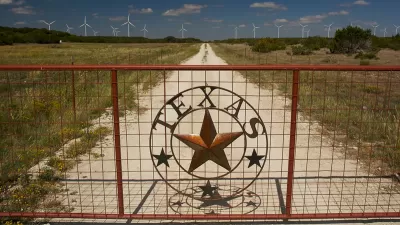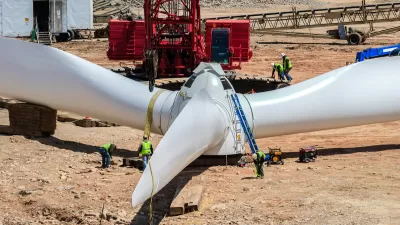The Wall Street Journal provides detailed coverage of the Texas wind energy industry, as well as the prospects for even greater adoption of renewable energy in the state.

"Texas has added more wind-based generating capacity than any other state, with wind turbines accounting for 16% of electrical generating capacity as of April," report Bill Spindle and Rebecca Smith. Now Texas is anticipating a huge surge in solar power.
As for how Texas, "one of the few reliably Republican states," jumped on the renewable energy bandwagon," Spindle and Smith trace the growth of the industry to former President George W. Bush's time in the governor's office.
The roots of Texas’ renewables boom go back to 1999, when then-Gov. George W. Bush and a Republican-dominated legislature overhauled the Texas power market. The free market-oriented deregulation broke the grip of most monopoly utilities that controlled generation, transmission and retail sales of electricity and introduced competitive auctions for wholesale power.
That market environment as enabled the state to create more than 19,000 megawatts of renewable capacity by April of 2016, according to the U.S. Department of Energy cited in the article. That's enough renewable energy to power 4 million homes.
Spindle and Smith reference the potential for similar growth in the Texas solar market in the future. Recent Planetizen coverage, however, has noted that solar businesses are struggling to gain momentum in the state.
The strength of the Texas wind energy industry, however, has been obvious since 2014, when the state began smashing its wind power records. There's also the city of Georgetown, near Austin, which announced its plans to go 100 percent renewable back in 2015.
FULL STORY: Which State Is a Big Renewable Energy Pioneer? Texas

Study: Maui’s Plan to Convert Vacation Rentals to Long-Term Housing Could Cause Nearly $1 Billion Economic Loss
The plan would reduce visitor accommodation by 25,% resulting in 1,900 jobs lost.

North Texas Transit Leaders Tout Benefits of TOD for Growing Region
At a summit focused on transit-oriented development, policymakers discussed how North Texas’ expanded light rail system can serve as a tool for economic growth.

Why Should We Subsidize Public Transportation?
Many public transit agencies face financial stress due to rising costs, declining fare revenue, and declining subsidies. Transit advocates must provide a strong business case for increasing public transit funding.

How Community Science Connects People, Parks, and Biodiversity
Community science engages people of all backgrounds in documenting local biodiversity, strengthening connections to nature, and contributing to global efforts like the City Nature Challenge to build a more inclusive and resilient future.

Alabama: Trump Terminates Settlements for Black Communities Harmed By Raw Sewage
Trump deemed the landmark civil rights agreement “illegal DEI and environmental justice policy.”

Dear Tesla Driver: “It’s not You, It’s Him.”
Amidst a booming bumper sticker industry, one writer offers solace to those asking, “Does this car make me look fascist?”
Urban Design for Planners 1: Software Tools
This six-course series explores essential urban design concepts using open source software and equips planners with the tools they need to participate fully in the urban design process.
Planning for Universal Design
Learn the tools for implementing Universal Design in planning regulations.
City of Santa Clarita
Ascent Environmental
Institute for Housing and Urban Development Studies (IHS)
City of Grandview
Harvard GSD Executive Education
Toledo-Lucas County Plan Commissions
Salt Lake City
NYU Wagner Graduate School of Public Service





























